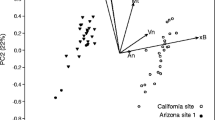Abstract
Tree volatiles and pheromones produced by southern bark beetles were bioassayed for response by the clerid predatorThanasimus dubius (F.). Upwind flights in a laboratory olfactometer, modified from Visser (1976), were used to determine the attractiveness of compounds. Differences in response to a solvent control and pheromone treatment were tested for statistical significance using the Wilcoxon signed ranks test. Both sexes ofT. dubius responded to frontalin, ipsdienol, and α-pinene in a dose-dependent manner with different but overlapping concentration ranges. Strong differences between the sexes were observed in response totrans-verbenol, verbenone, andl-β-pinene. Neither sex responded to ipsenol orendo-brevicomin.
Similar content being viewed by others
References
Bakke, A., andTorstein, K. 1981. Kairomone response in Thanasimus predators to pheromone components ofIps typographus.J. Chem. Ecol. 7:305–312.
Bedard, W.D., Wood, D.L., Tilden, P.E., Lindahl, K.Q., Jr., Silverstein, R.M. andRodin, J.O. 1980. Field responses of the western pine beetle and one of its predators to host- and beetle-produced compounds.J. Chem. Ecol. 6:625–641.
Berisford, C.W. 1973. Parasite abundance inIps spp. infestations as influenced by the southern pine beetle.Environ. Entomol. 3:695–696.
Berisford, C.W. 1981. Natural enemies and associated organisms,in R.C.Thatcher, J.L. Searcy, J.E. Coster, and G.D. Hertel. (eds.). The Southern Pine Beetle USDA Tech Bull. 1631.
Birch, M.C., Svihra, P., Paine, T.D., andMiller, J.C. 1980. Influence of chemically mediated behavior on host tree colonization by four cohabiting species of bark beetles.J. Chem. Ecol. 6:395–414.
Dixon, W.N., andPayne, T.L. 1980. Attraction of entomophagous and associate insects of the southern pine beetle to beetle- and host tree-produced volatiles.J. Ga. Entomol. Soc. 15:378–389
Fronk, W.D. 1947. The southern pine beetle—its life history.Va. Agr. Exp. Sta. Tech. Bull. 108.
Hedden, R., Vité, J.P., andMori, K. 1976. Synergistic effect of a pheromone and kairomone on host selection and colonization byIps avulsus.Nature 261:696–697.
Kinzer, G.W., Fentiman, A.F., Jr., Foltz, R.L., Vité, J.P., andPitman, G.B. 1969. Bark beetle attractants: identification, synthesis, and field bioassay of a new compound isolated fromDendroctonus.Nature 221:477–478.
Kudon, L.H., andBerisford, C.W. 1980. Influence of brood hosts on host preferences of bark beetle parasites.Nature 283:288–290.
Mason, R.R. 1970. Comparison of flight aggregation in two species of southernIps(Coleoptera: Scolytidae).Can. Entomol. 102:1036–1041.
Mignot, E.C., andAnderson, R.F. 1969. Bionomics of the bark beetle predator,Thanasimus dubius (F.) (Coleoptera: Cleridae).Entomol. News 80:305–310.
Mizell, R.F. 1981.Thanasimus dubius (F.): Some behavior factors affecting its predatory role. PhD dissertation. Mississippi State University. 175 pp.
Mizell, R.F., Nebeker, T.E., andFrazier, J.L. 1982. Preference and oviposition rates of adultThanasimus dubius (F.) on three prey species.Environ. Entomol. 11:139–143.
Nebeker, T.E., Purser, G., andMizell, R.F. 1980. Collection and maintenance ofThanasimus dubius (F.) for biological and behavioral studies.J. Ga. Entomol. Soc. 15(4):406–412.
Nie, N.H., andHull, C.H. 1977. Statistical Package for the Social Sciences, Batch Release 7.0 Update Manual. McGraw-Hill, New York. 135 pp.
Payne, T.L. 1970. Electrophysical investigations on response to pheromones in bark beetles.Contrib. Boyce Thompson Inst. 24:275–282.
Payne, T.L., Coster, J.E., Richerson, J.V., Edson, L.J., andHart, E.R. 1978. Field response of the southern pine beetle to behavioral chemicals.Environ. Entomol. 7:578–582.
Renwick, J.A.A., andVité, J.P. 1972. Pheromones and host volatiles that govern aggregation of the six-spined engraver beetle,Ips calligraphus.J. Insect Physiol. 18:1215–1219.
Renwick, J.A.A., Huges, P.R., andKrull, I.S. 1976. Selective production ofcis- andtrans-verbenol from (−)- and (+)-α-pinene by a bark beetle.Science 191:199–201.
Rose, W.F., III, Billings, R.F., andVité, J.P. 1981. Southern pine bark beetles: Evaluations of non-sticky pheromone trap designs for survey and research.Southwest, Entomol. 6:1–9.
Rudinsky, J.A. 1973. Multiple functions of the southern pine beetle pheromone verbenone.Environ. Entomol. 2:511–514.
Thatcher, R.C., andPickard, L.S. 1966. The clerid beetleThanasimus dubius: A predator of the southern pine beetle.J. Econ. Entomol. 59:955–957.
Visser, J.H. 1976. The design of a low-speed wind tunnel as an instrument for study of olfactory orientation in the Colorado potato beetle (Leptinotarsa decemlineata)Entomol. Exp. Appl. 20:275–288.
Vité, J.P., andRenwick, J.A.A. 1968. Insect and host factors in the aggregation of the southern pine beetle.Contrib. Boyce Thompson Inst. 24:61–63.
Vité, J.P., andRenwick, J.A.A. 1971a. Population aggregating pheromone in the bark beetleIps grandicollis.J. Insect Physiol. 17:1699–1704.
Vité, J.P., andRenwick, J.A.A. 1971b. Inhibition ofDendroctonus frontalis response to frontalin and isomers of brevicomin.Naturwissenschaften 58:418.
Vité, J.P., andWilliamson, D.L. 1970.Thanasimus dubius: Prey perception. J. Insect Physiol. 106:233–239.
Vité, J.P., Gara, R.I., andVon Scheller, H.D. 1964. Field observations on the response to attractants of bark beetles infesting southern pines.Contrib. Boyce Thompson Inst. 22:461–470.
Vité, J.P., Bakke, A., andRenwick, J.A.A. 1972. Pheromones inIps (Coleoptera: Scolytidae) occurrence and production.Can. Entomol. 104:1967–1975.
Werner, R.A. 1972a. Aggregation behavior of the beetleIps grandicollis in response to host-produced attractants.J. Insect Physiol. 18:423–437.
Werner, R.A. 1972b. Aggregation behavior of the beetleIps grandicollis in response to insect-produced attractants.J. Insect Physiol. 18:1001–1013.
Author information
Authors and Affiliations
Additional information
Miss. Agric. and For. Exp. Sta. Publication No. 5251.
Rights and permissions
About this article
Cite this article
Mizell, R.F., Frazier, J.L. & Nebeker, T.E. Response of the clerid predatorThanasimus dubius (F.) to bark beetle pheromones and tree volatiles in a wind tunnel. J Chem Ecol 10, 177–187 (1984). https://doi.org/10.1007/BF00987655
Received:
Revised:
Issue Date:
DOI: https://doi.org/10.1007/BF00987655




